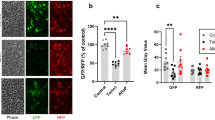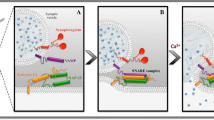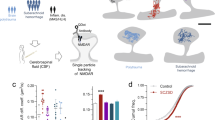Abstract
Valproate exposure is associated with increased risks of autism spectrum disorder. To date, the mechanistic details of disturbance of melatonin receptor subtype 1 (MTNR1A) internalization upon valproate exposure remain elusive. By expressing epitope-tagged receptors (MTNR1A-EGFP) in HEK-293 and Neuro-2a cells, we recorded the dynamic changes of MTNR1A intracellular trafficking after melatonin treatment. Using time-lapse confocal microscopy, we showed in living cells that valproic acid interfered with the internalization kinetics of MTNR1A in the presence of melatonin. This attenuating effect was associated with a decrease in the phosphorylation of PKA (Thr197) and ERK (Thr202/Tyr204). VPA treatment did not alter the whole-cell currents of cells with or without melatonin. Furthermore, fluorescence resonance energy transfer imaging data demonstrated that valproic acid reduced the melatonin-initiated association between YFP-labeled β-arrestin 2 and CFP-labeled MTNR1A. Together, we suggest that valproic acid influences MTNR1A intracellular trafficking and signaling in a β-arrestin 2-dependent manner.





Similar content being viewed by others
Abbreviations
- VPA:
-
2-Propylpentanoic acid
- MTNR1A:
-
Melatonin receptor subtype 1
- PKA:
-
Protein kinase A
- PKC:
-
Protein kinase C
- FRET:
-
Fluorescence resonance energy transfer
References
Stehle JH, Saade A, Rawashdeh O, Ackermann K, Jilg A, Sebesteny T, Maronde E (2011) A survey of molecular details in the human pineal gland in the light of phylogeny, structure, function and chronobiological diseases. J Pineal Res 51(1):17–43
Kulman G, Lissoni P, Rovelli F, Roselli MG, Brivio F, Sequeri P (2000) Evidence of pineal endocrine hypofunction in autistic children. Neuroendocrinol Lett 21(1):31–34
Jonsson PD, Wijk H, Danielson E, Skarsater I (2011) Outcomes of an educational intervention for the family of a person with bipolar disorder: a 2-year follow-up study. J Psychiatr Ment Health Nurs 18(4):333–341
Chaste P, Clement N, Mercati O, Guillaume JL, Delorme R, Botros HG, Pagan C, Perivier S, Scheid I, Nygren G, Anckarsater H, Rastam M, Stahlberg O, Gillberg C, Serrano E, Lemiere N, Launay JM, Mouren-Simeoni MC, Leboyer M, Gillberg C, Jockers R, Bourgeron T (2010) Identification of pathway-biased and deleterious melatonin receptor mutants in autism spectrum disorders and in the general population. PLoS ONE 5(7):e11495
Yasuhara A, Chaki S (2010) Metabotropic glutamate receptors: potential drug targets for psychiatric disorders. Open Med Chem J 4:20–36
Christensen J, Gronborg TK, Sorensen MJ, Schendel D, Parner ET, Pedersen LH, Vestergaard M (2013) Prenatal valproate exposure and risk of autism spectrum disorders and childhood autism. JAMA 309(16):1696–1703
Leyfer OT, Folstein SE, Bacalman S, Davis NO, Dinh E, Morgan J, Tager–Flusberg H, Lainhart JE (2006) Comorbid psychiatric disorders in children with autism: interview development and rates of disorders. J Autism Dev Disord 36(7):849–861
Tian Y, Yabuki Y, Moriguchi S, Fukunaga K, Mao PJ, Hong LJ, Lu YM, Wang R, Ahmed MM, Liao MH, Huang JY, Zhang RT, Zhou TY, Long S, Han F (2014) Melatonin reverses the decreases in hippocampal protein serine/threonine kinases observed in an animal model of autism. J Pineal Res 56(1):1–11
Cortesi F, Giannotti F, Sebastiani T, Panunzi S, Valente D (2012) Controlled-release melatonin, singly and combined with cognitive behavioural therapy, for persistent insomnia in children with autism spectrum disorders: a randomized placebo-controlled trial. J Sleep Res 21(6):700–709
Malow B, Adkins KW, McGrew SG, Wang L, Goldman SE, Fawkes D, Burnette C (2012) Melatonin for sleep in children with autism: a controlled trial examining dose, tolerability, and outcomes. J Autism Dev Disord 42(8):1729–1737, author reply 1738
Doyen C, Mighiu D, Kaye K, Colineaux C, Beaumanoir C, Mouraeff Y, Rieu C, Paubel P, Contejean Y (2011) Melatonin in children with autistic spectrum disorders: recent and practical data. Eur Child Adolesc Psychiatry 20(5):231–239
Rossignol DA (2009) Novel and emerging treatments for autism spectrum disorders: a systematic review. Ann Clin Psychiatry 21(4):213–236
Gitto E, Aversa S, Reiter RJ, Barberi I, Pellegrino S (2011) Update on the use of melatonin in pediatrics. J Pineal Res 50(1):21–28
Reiter RJ, Tan DX, Madrid JA, Erren TC (2012) When the circadian clock becomes a ticking time bomb. Chronobiol Int 29(9):1286–1287
Beaulieu JM, Marion S, Rodriguiz RM, Medvedev IO, Sotnikova TD, Ghisi V, Wetsel WC, Lefkowitz RJ, Gainetdinov RR, Caron MG (2008) A beta-arrestin 2 signaling complex mediates lithium action on behavior. Cell 132(1):125–136
Raveh A, Cooper A, Guy-David L, Reuveny E (2010) Nonenzymatic rapid control of GIRK channel function by a G protein-coupled receptor kinase. Cell 143(5):750–760
Ozawa K, Whalen EJ, Nelson CD, Mu Y, Hess DT, Lefkowitz RJ, Stamler JS (2008) S-nitrosylation of beta-arrestin regulates beta-adrenergic receptor trafficking. Mol Cell 31(3):395–405
Rosales-Corral SA, Acuna-Castroviejo D, Coto-Montes A, Boga JA, Manchester LC, Fuentes-Broto L, Korkmaz A, Ma S, Tan DX, Reiter RJ (2012) Alzheimer’s disease: pathological mechanisms and the beneficial role of melatonin. J Pineal Res 52(2):167–202
Hardeland R, Poeggeler B (2012) Melatonin and synthetic melatonergic agonists: actions and metabolism in the central nervous system. Cent Nerv Syst Agents Med Chem 12(3):189–216
Jan JE, Reiter RJ, Wasdell MB, Bax M (2009) The role of the thalamus in sleep, pineal melatonin production, and circadian rhythm sleep disorders. J Pineal Res 46(1):1–7
Bondi CD, McKeon RM, Bennett JM, Ignatius PF, Brydon L, Jockers R, Melan MA, Witt-Enderby PA (2008) MT1 melatonin receptor internalization underlies melatonin-induced morphologic changes in Chinese hamster ovary cells and these processes are dependent on Gi proteins, MEK 1/2 and microtubule modulation. J Pineal Res 44(3):288–298
Kim B, Rincon CLM, Jawed S, Niles LP (2008) Clinically relevant concentrations of valproic acid modulate melatonin MT(1) receptor, HDAC and MeCP2 mRNA expression in C6 glioma cells. Eur J Pharmacol 589(1–3):45–48
Huang H, He X, Deng X, Li G, Ying G, Sun Y, Shi L, Benovic JL, Zhou N (2010) Bombyx adipokinetic hormone receptor activates extracellular signal-regulated kinase 1 and 2 via G protein-dependent PKA and PKC but beta-arrestin-independent pathways. Biochemistry 49(51):10862–10872
Orsini MJ, Parent JL, Mundell SJ, Marchese A, Benovic JL (1999) Trafficking of the HIV coreceptor CXCR4. Role of arrestins and identification of residues in the c-terminal tail that mediate receptor internalization. J Biol Chem 274(43):31076–31086
Li G, Shi Y, Huang H, Zhang Y, Wu K, Luo J, Sun Y, Lu J, Benovic JL, Zhou N (2010) Internalization of the human nicotinic acid receptor GPR109A is regulated by G(i), GRK2, and arrestin3. J Biol Chem 285(29):22605–22618
Thompson BA, Storm MP, Hewinson J, Hogg S, Welham MJ, MacKenzie AB (2012) A novel role for P2X7 receptor signalling in the survival of mouse embryonic stem cells. Cell Signal 24(3):770–778
Han F, Chen YX, Lu YM, Huang JY, Zhang GS, Tao RR, Ji YL, Liao MH, Fukunaga K, Qin ZH (2011) Regulation of the ischemia-induced autophagy-lysosome processes by nitrosative stress in endothelial cells. J Pineal Res 51(1):124–135
Kenworthy AK (2001) Imaging protein–protein interactions using fluorescence resonance energy transfer microscopy. Methods 24(3):289–296
Macia E, Partisani M, Paleotti O, Luton F, Franco M (2012) Arf6 negatively controls the rapid recycling of the beta2 adrenergic receptor. J Cell Sci 125(Pt 17):4026–4035
Liggett SB (2011) Phosphorylation barcoding as a mechanism of directing GPCR signaling. Sci Signal 4(185):pe36
Bastin G, Heximer SP (2013) Rab family proteins regulate the endosomal trafficking and function of RGS4. J Biol Chem 288(30):21836–21849
Barrowman J, Bhandari D, Reinisch K, Ferro-Novick S (2010) TRAPP complexes in membrane traffic: convergence through a common Rab. Nat Rev Mol Cell Biol 11(11):759–763
Chowanadisai W, Graham DM, Keen CL, Rucker RB, Messerli MA (2013) Neurulation and neurite extension require the zinc transporter ZIP12 (slc39a12). Proc Natl Acad Sci U S A 110(24):9903–9908
Tjong YW, Li MF, Hung MW, Fung ML (2008) Melatonin ameliorates hippocampal nitric oxide production and large conductance calcium-activated potassium channel activity in chronic intermittent hypoxia. J Pineal Res 44(3):234–243
Cui P, Yu M, Luo Z, Dai M, Han J, Xiu R, Yang Z (2008) Intracellular signaling pathways involved in cell growth inhibition of human umbilical vein endothelial cells by melatonin. J Pineal Res 44(1):107–114
Chen L, He X, Zhang Y, Chen X, Lai X, Shao J, Shi Y, Zhou N (2014) Melatonin receptor type 1 signals to extracellular signal-regulated kinase 1 and 2 via Gi and Gs dually coupled pathways in HEK-293 cells. Biochemistry 53(17):2827–2839
Toth DJ, Toth JT, Gulyas G, Balla A, Balla T, Hunyady L, Varnai P (2012) Acute depletion of plasma membrane phosphatidylinositol 4,5-bisphosphate impairs specific steps in endocytosis of the G-protein-coupled receptor. J Cell Sci 125(Pt 9):2185–2197
Hamdan FF, Rochdi MD, Breton B, Fessart D, Michaud DE, Charest PG, Laporte SA, Bouvier M (2007) Unraveling G protein-coupled receptor endocytosis pathways using real-time monitoring of agonist-promoted interaction between beta-arrestins and AP-2. J Biol Chem 282(40):29089–29100
Schneider T, Przewlocki R (2005) Behavioral alterations in rats prenatally exposed to valproic acid: animal model of autism. Neuropsychopharmacology 30(1):80–89
Roullet FI, Wollaston L, Decatanzaro D, Foster JA (2010) Behavioral and molecular changes in the mouse in response to prenatal exposure to the anti-epileptic drug valproic acid. Neuroscience 170(2):514–522
Vinten J, Adab N, Kini U, Gorry J, Gregg J, Baker GA (2005) Neuropsychological effects of exposure to anticonvulsant medication in utero. Neurology 64(6):949–954
Sethi S, Adams W, Pollock J, Witt-Enderby PA (2008) C-terminal domains within human MT1 and MT2 melatonin receptors are involved in internalization processes. J Pineal Res 45(2):212–218
Jarzynka MJ, Passey DK, Ignatius PF, Melan MA, Radio NM, Jockers R, Rasenick MM, Brydon L, Witt-Enderby PA (2006) Modulation of melatonin receptors and G-protein function by microtubules. J Pineal Res 41(4):324–336
Bottanelli F, Gershlick DC, Denecke J (2012) Evidence for sequential action of Rab5 and Rab7 GTPases in prevacuolar organelle partitioning. Traffic 13(2):338–354
Madsen KL, Thorsen TS, Rahbek-Clemmensen T, Eriksen J, Gether U (2012) Protein interacting with C kinase 1 (PICK1) reduces reinsertion rates of interaction partners sorted to Rab11-dependent slow recycling pathway. J Biol Chem 287(15):12293–12308
Gazarini ML, Beraldo FH, Almeida FM, Bootman M, Da SAM, Garcia CR (2011) Melatonin triggers PKA activation in the rodent malaria parasite Plasmodium chabaudi. J Pineal Res 50(1):64–70
Zhao WJ, Zhang M, Miao Y, Yang XL, Wang Z (2010) Melatonin potentiates glycine currents through a PLC/PKC signalling pathway in rat retinal ganglion cells. J Physiol 588(Pt 14):2605–2619
Baba K, Tumuraya K, Tanaka I, Yao M, Uchiumi T (2013) Molecular dissection of the silkworm ribosomal stalk complex: the role of multiple copies of the stalk proteins. Nucleic Acids Res 41(6):3635–3643
Maurice P, Daulat AM, Turecek R, Ivankova-Susankova K, Zamponi F, Kamal M, Clement N, Guillaume JL, Bettler B, Gales C, Delagrange P, Jockers R (2010) Molecular organization and dynamics of the melatonin MT(1) receptor/RGS20/G(i) protein complex reveal asymmetry of receptor dimers for RGS and G(i) coupling. EMBO J 29(21):3646–3659
Jordan BA, Devi LA (1999) G-protein-coupled receptor heterodimerization modulates receptor function. Nature 399(6737):697–700
Acknowledgments
This work was supported by the National Natural Science Foundations of China (81402908, 81403024), Foundations of Hangzhou City Science and Technology Project (20130633B01), Foundations of Zhejiang Pharmaceutical Society (2013ZYY39), and Zhejiang Provincial Natural Science Foundation of China (LQ13H310001).
Conflict of interests
The authors declare no conflicts of interest.
Author information
Authors and Affiliations
Corresponding authors
Additional information
Ling-juan Hong and Quan Jiang contributed equally to this work.
Rights and permissions
About this article
Cite this article
Hong, Lj., Jiang, Q., Long, S. et al. Valproic Acid Influences MTNR1A Intracellular Trafficking and Signaling in a β-Arrestin 2-Dependent Manner. Mol Neurobiol 53, 1237–1246 (2016). https://doi.org/10.1007/s12035-014-9085-y
Received:
Accepted:
Published:
Issue Date:
DOI: https://doi.org/10.1007/s12035-014-9085-y




